Yesterday, collector Didier Hanson sent me these scans of Russian film postcards from the pre-Soviet era. I liked them so much that I wanted to present them today to you. So, here are incredibly rare postcards of silent stars like Vera Karalli, Nathalie Kovanko, Vitold Polonsky, Ossip Runitsch, Vladimir Maximov and of course the greatest Russian diva of that era, Vera Kholodnaya. Thanks for sharing, Didier!
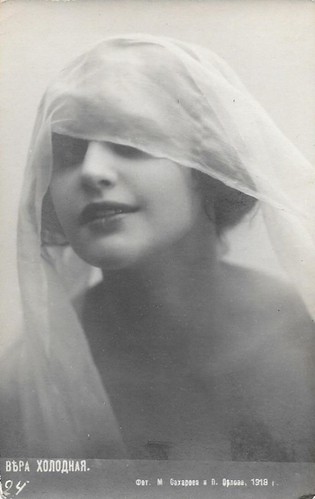
Vera Kholodnaya. Russian postcard, no. 24, 1918. Collection: Didier Hanson.
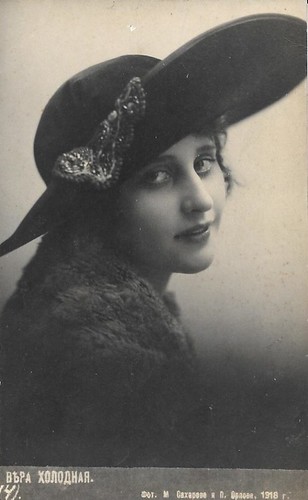
Vera Kholodnaya. Russian postcard, no. 141, 1918. Collection: Didier Hanson.
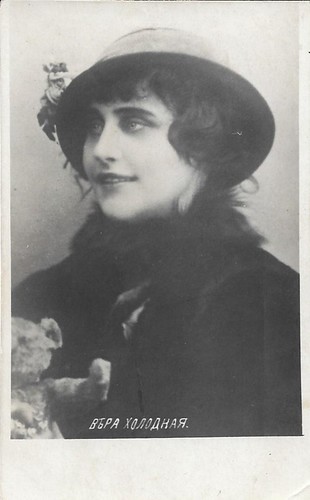
Vera Kholodnaya. Russian postcard, no. 30. Collection: Didier Hanson.
The Cinema of the Russian Empire roughly spans the period 1907-1920, during which time a strong infrastructure was created. From the over 2,700 art films created in Russia before 1920, around 300 remain to this day.
In 1908, Alexander Drankov produced the first Russian narrative film, Stenka Razin, based on events told in a popular folk song and directed by Vladimir Romashkov.
At the same time, the Moscow cinema entrepreneur Aleksandr Khanzhonkov began to operate. In 1912, the Khanzhonkov film studio was operational.
The same year, a German concern filming in Russia introduced the director Yakov Protazanov to the world with its Ukhod Velikovo Startsa/Departure of the Grand Old Man, a biographical film about Lev Tolstoy.
From 1911 to 1914 Ivan Mozzhukhin worked in the silent films of Khanzhonkov.
Mozzhukhin shot to fame after his leading role as violinist Trukhachevsky in Kreitzerova sonata/The Kreutzer Sonata (Pyotr Chardynin, 1911), based on the eponymous story by Leo Tolstoy.
He starred as Admiral Kornilov in Oborona Sevastopolya/Defence of Sevastopol (Vasili Goncharov, Aleksandr Khanzhonkov, 1911), a feature film of 2000 meters. This was the first film ever that was shot by two cameras.
Next he appeared in the delightful comedy Domik v Kolomne/The Kolomna House (Pyotr Chardynin, 1913) after a poem by Alexander Pushkin.
By the mid-1910s Ivan Mozzhukhin had become the most important male star of the Cinema of the Russian Empire.
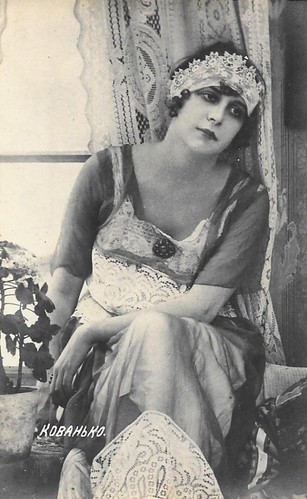
Nathalie Kovanko. Russian postcard. Collection: Didier Hanson.
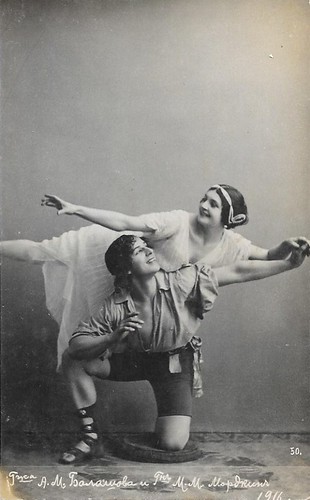
Alexandra Balashova and Mikhail Mortkin. Russian postcard, no. 30. Collection: Didier Hanson.
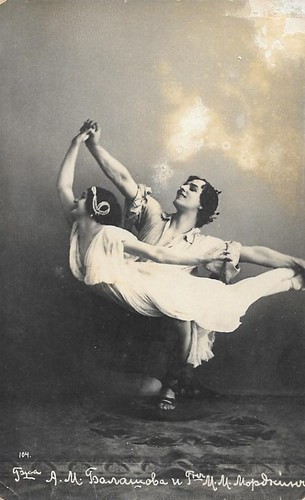
Alexandra Balashova and Mikhail Mortkin. Russian postcard, no. 144. Collection: Didier Hanson.

Vitold Polonsky and Vera Karalli. Russian postcard. Collection: Didier Hanson. Photo: publicity still for Vozmezdie/Retribution (Yevgeni Bauer, 1916).
The arrival of World War I in Russia in 1914 sparked a change in the Cinema of the Russian Empire.
In 1916, Russia produced 499 films, over three times the number of just three years earlier, and more of feature length.
Russia's war allies began to import some of the more striking product, including films by Yakov Protazanov and Yevgeni Bauer, a specialist in psychological film, who both impacted, among others, the burgeoning American film industry.
And then came the Russian Revolution. With audiences turning against the Tsar, film producers began turning out, after the February Revolution, a number of films with anti-Tsarist themes. These, along with the usual retinue of detective films and melodramas, filled theatres.
The destruction of the infrastructure in the major cities, the failing war-drained economy, the takeover of rural cinemas by local Soviets, and the aversion of some in the film industry to communism, caused the Russian film industry per se to effectively die out by the time Lenin on 8 November 1917 proclaimed a new country, the Russian Soviet Federative Socialist Republic.
The last significant Russian film completed, Otets Sergiy/Father Sergius (Yakov Protazanov, Alexandre Volkoff, 1917) featuring Ivan Mozzhukhin would become the first new film release a year later, in the new country of the Soviets.
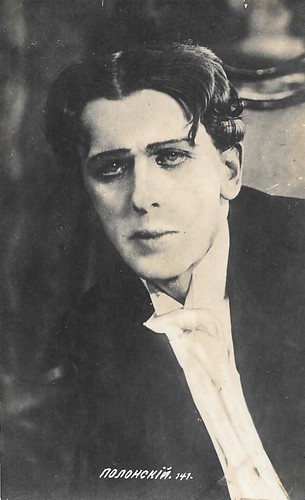
Vitold Polonsky, no. 141. Russian postcard. Collection: Didier Hanson.
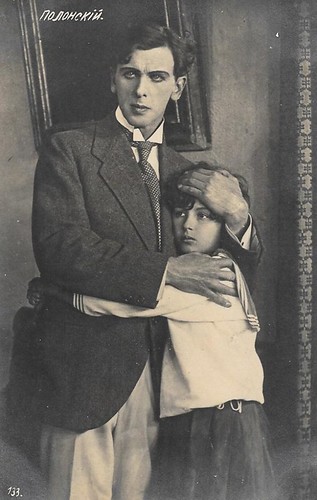
Vitold Polonsky. Russian postcard, no. 133. Collection: Didier Hanson.
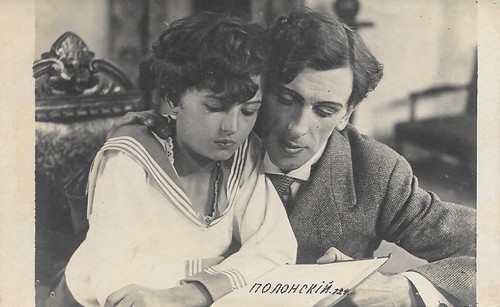
Vitold Polonsky. Russian postcard, no. 124. Collection: Didier Hanson.
One of the first stars of the Cinema of the Russian Empire was Vera Kholodnaya (1893-1919).
Her film debut was a minor role in a grand production of Anna Karenina (Vladimir Gardin, 1914) with Mariya Germanova in the title role.
Then director Yevgeni Bauer was looking for a woman of outstanding beauty for a new film. When Kholodnaya was introduced to him, Bauer reportedly was spellbound of the small, intense woman with her commanding grey eyes and mop of black hair.
Bauer at once approved her for the part, the lead role in the Ivan Turgenev adaptation Pesn torzhestvuyushchey lyubvi/The Song of the Triumphant Love (Yevgeni Bauer, 1915).
This mystical love drama was a major box-office hit, and she signed a three-years contract with the Khanzhonkov studio. The impatient Bauer immediately made another film with his new discovery, Plamya Neba/Flame of the Sky (Yevgeni Bauer, 1915).
Four years later, the ‘Queen of the Screen’ died of the Spanish flu during the pandemic of 1919.
There were also rumours about a Mata Hari-like intrigue. Her death should be attributed to poisoning following a love story with the Spanish Ambassador...
Although the 26-years old actress had worked only three years for the cinema, she must have made between fifty and hundred short films.
The Soviet authorities ordered to destroy many of the Kholodnaya features in 1924, and only five of her films still exist.
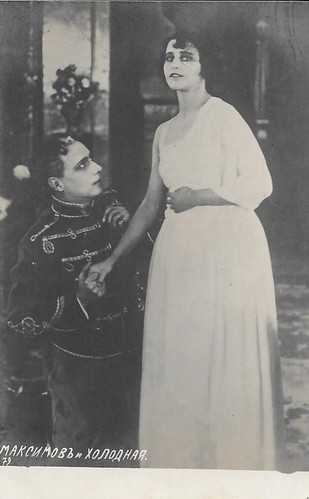
Vera Kholodnaya and Vladimir Maximov. Russian postcard, no. 79. Collection: Didier Hanson.

Vera Kholodnaya and Ossip Runitsch. Russian postcard, no. 30. Collection: Didier Hanson.
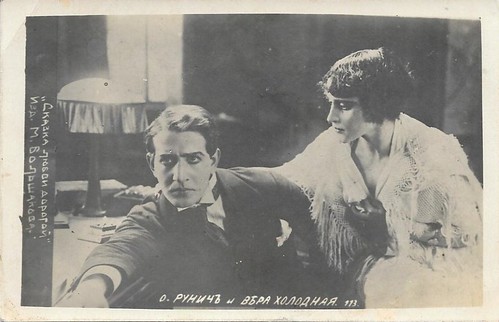
Vera Kholodnaya and Ossip Runitsch. Russian postcard, no. 173. Collection: Didier Hanson.
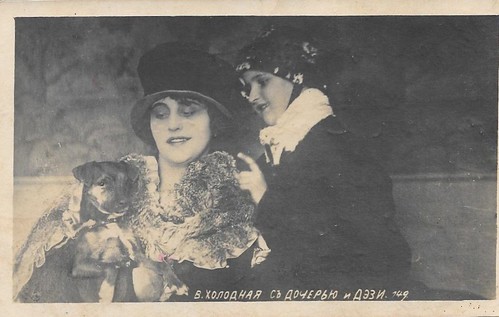
Vera Kholodnaya. Russian postcard, no. 149. Collection: Didier Hanson.
Sources: Wikipedia and IMDb.

Vera Kholodnaya. Russian postcard, no. 24, 1918. Collection: Didier Hanson.

Vera Kholodnaya. Russian postcard, no. 141, 1918. Collection: Didier Hanson.

Vera Kholodnaya. Russian postcard, no. 30. Collection: Didier Hanson.
A Strong Infrastructure
The Cinema of the Russian Empire roughly spans the period 1907-1920, during which time a strong infrastructure was created. From the over 2,700 art films created in Russia before 1920, around 300 remain to this day.
In 1908, Alexander Drankov produced the first Russian narrative film, Stenka Razin, based on events told in a popular folk song and directed by Vladimir Romashkov.
At the same time, the Moscow cinema entrepreneur Aleksandr Khanzhonkov began to operate. In 1912, the Khanzhonkov film studio was operational.
The same year, a German concern filming in Russia introduced the director Yakov Protazanov to the world with its Ukhod Velikovo Startsa/Departure of the Grand Old Man, a biographical film about Lev Tolstoy.
From 1911 to 1914 Ivan Mozzhukhin worked in the silent films of Khanzhonkov.
Mozzhukhin shot to fame after his leading role as violinist Trukhachevsky in Kreitzerova sonata/The Kreutzer Sonata (Pyotr Chardynin, 1911), based on the eponymous story by Leo Tolstoy.
He starred as Admiral Kornilov in Oborona Sevastopolya/Defence of Sevastopol (Vasili Goncharov, Aleksandr Khanzhonkov, 1911), a feature film of 2000 meters. This was the first film ever that was shot by two cameras.
Next he appeared in the delightful comedy Domik v Kolomne/The Kolomna House (Pyotr Chardynin, 1913) after a poem by Alexander Pushkin.
By the mid-1910s Ivan Mozzhukhin had become the most important male star of the Cinema of the Russian Empire.

Nathalie Kovanko. Russian postcard. Collection: Didier Hanson.

Alexandra Balashova and Mikhail Mortkin. Russian postcard, no. 30. Collection: Didier Hanson.

Alexandra Balashova and Mikhail Mortkin. Russian postcard, no. 144. Collection: Didier Hanson.

Vitold Polonsky and Vera Karalli. Russian postcard. Collection: Didier Hanson. Photo: publicity still for Vozmezdie/Retribution (Yevgeni Bauer, 1916).
Change
The arrival of World War I in Russia in 1914 sparked a change in the Cinema of the Russian Empire.
In 1916, Russia produced 499 films, over three times the number of just three years earlier, and more of feature length.
Russia's war allies began to import some of the more striking product, including films by Yakov Protazanov and Yevgeni Bauer, a specialist in psychological film, who both impacted, among others, the burgeoning American film industry.
And then came the Russian Revolution. With audiences turning against the Tsar, film producers began turning out, after the February Revolution, a number of films with anti-Tsarist themes. These, along with the usual retinue of detective films and melodramas, filled theatres.
The destruction of the infrastructure in the major cities, the failing war-drained economy, the takeover of rural cinemas by local Soviets, and the aversion of some in the film industry to communism, caused the Russian film industry per se to effectively die out by the time Lenin on 8 November 1917 proclaimed a new country, the Russian Soviet Federative Socialist Republic.
The last significant Russian film completed, Otets Sergiy/Father Sergius (Yakov Protazanov, Alexandre Volkoff, 1917) featuring Ivan Mozzhukhin would become the first new film release a year later, in the new country of the Soviets.

Vitold Polonsky, no. 141. Russian postcard. Collection: Didier Hanson.

Vitold Polonsky. Russian postcard, no. 133. Collection: Didier Hanson.

Vitold Polonsky. Russian postcard, no. 124. Collection: Didier Hanson.
Vera Kholodnaya
One of the first stars of the Cinema of the Russian Empire was Vera Kholodnaya (1893-1919).
Her film debut was a minor role in a grand production of Anna Karenina (Vladimir Gardin, 1914) with Mariya Germanova in the title role.
Then director Yevgeni Bauer was looking for a woman of outstanding beauty for a new film. When Kholodnaya was introduced to him, Bauer reportedly was spellbound of the small, intense woman with her commanding grey eyes and mop of black hair.
Bauer at once approved her for the part, the lead role in the Ivan Turgenev adaptation Pesn torzhestvuyushchey lyubvi/The Song of the Triumphant Love (Yevgeni Bauer, 1915).
This mystical love drama was a major box-office hit, and she signed a three-years contract with the Khanzhonkov studio. The impatient Bauer immediately made another film with his new discovery, Plamya Neba/Flame of the Sky (Yevgeni Bauer, 1915).
Four years later, the ‘Queen of the Screen’ died of the Spanish flu during the pandemic of 1919.
There were also rumours about a Mata Hari-like intrigue. Her death should be attributed to poisoning following a love story with the Spanish Ambassador...
Although the 26-years old actress had worked only three years for the cinema, she must have made between fifty and hundred short films.
The Soviet authorities ordered to destroy many of the Kholodnaya features in 1924, and only five of her films still exist.

Vera Kholodnaya and Vladimir Maximov. Russian postcard, no. 79. Collection: Didier Hanson.

Vera Kholodnaya and Ossip Runitsch. Russian postcard, no. 30. Collection: Didier Hanson.

Vera Kholodnaya and Ossip Runitsch. Russian postcard, no. 173. Collection: Didier Hanson.

Vera Kholodnaya. Russian postcard, no. 149. Collection: Didier Hanson.
Sources: Wikipedia and IMDb.
No comments:
Post a Comment